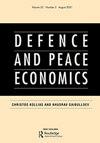军事开支对经济增长的影响:一种新的工具变量方法
IF 1.6
3区 经济学
Q2 ECONOMICS
引用次数: 0
摘要
内生性问题一直困扰着估算军事开支对经济增长影响的努力。本文用两种军事开支工具来解决这个问题:和平时期武器进口的价值和遭受国家间暴力的邻国的数量。武器进口的价值虽然与军事开支呈正相关,但不太可能由经济增长决定,因为在这些武器的采购订单和交付之间存在着时间上的滞后,在许多情况下,这种滞后长达数年。遭受州际暴力的邻国数量反映了地区“政治不确定性”,这刺激了军事开支,而没有反映可能直接影响经济增长的国内政治暴力的实际规模。几项诊断试验表明,这两种仪器都与军事开支高度相关,并满足过度识别的限制。对1960年至2012年期间133个国家的面板数据进行实证分析的结果表明,军费开支/GDP每增加1个百分点,经济增长率就会下降1.10个百分点。这些结果对2SLS、LIML和GMM估计器的应用具有鲁棒性。本文章由计算机程序翻译,如有差异,请以英文原文为准。
The Impact of Military Expenditures on Economic Growth: A New Instrumental Variables Approach
Endogeneity problems have plagued efforts to estimate the impact of military expenditures on economic growth. This paper addresses this problem with two instruments for military expenditures: the value of arms imports during periods of peace and the number of neighboring states suffering interstate violence. While positively correlated with military expenditures, the value of arms imports is unlikely to be determined by economic growth because of the time lag which exists, which in many cases runs into several years, between the placement of purchase orders for these arms and their delivery. The number of neighboring states suffering interstate violence captures regional ‘political uncertainty’, which spurs military spending without capturing the actual scale of domestic political violence which may directly affect economic growth. Several diagnostic tests show that both these instruments are highly correlated with military expenditures and fulfill overidentification restrictions. The results from empirical analyses of panel data on 133 countries during the 1960-2012 period indicate that an increase in military expenditure/GDP of 1 percentage point reduces economic growth by 1.10 percentage points. These results are robust to the application of 2SLS, LIML, and GMM estimators.
求助全文
通过发布文献求助,成功后即可免费获取论文全文。
去求助
来源期刊

Defence and Peace Economics
ECONOMICS-
CiteScore
4.00
自引率
18.80%
发文量
45
期刊介绍:
Defence and Peace Economics embraces all aspects of the economics of defence, disarmament, conversion and peace. Examples include the study of alliances and burden-sharing; military spending in developed and developing nations; arms races; terrorism; country surveys; the impact of disarmament on employment and unemployment; the prospects for conversion and the role of public policy in assisting the transition; the costs and benefits of arms control regimes; the arms trade; economic sanctions; the role of the United Nations.
 求助内容:
求助内容: 应助结果提醒方式:
应助结果提醒方式:


